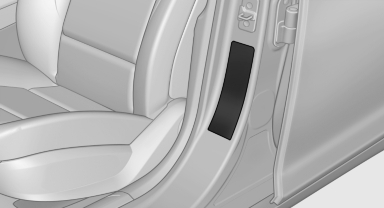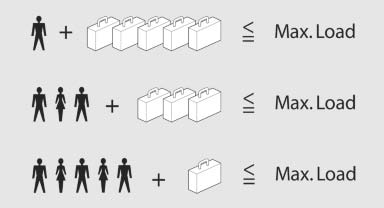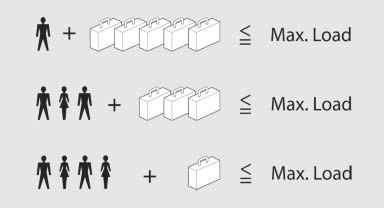Determining the load limit

1. Locate the following statement on your vehicle’s placard*:
- The combined weight of occupants and cargo should never exceed XXX kg or YYY lbs. Otherwise, damage to the vehicle and unstable driving situations may result.
2. Determine the combined weight of the driver and passengers that will be riding in your vehicle.
3. Subtract the combined weight of the driver and passengers from XXX kilograms or YYY pounds.
4. The resulting figure equals the available amount of cargo and luggage load capacity. For example, if the YYY amount equals 1,000 lbs and there will be four 150 lbs passengers in your vehicle, the amount of available cargo and luggage load capacity is 400 lbs: 1,000 lbs minus 600 lbs = 400 lbs.
5. Determine the combined weight of luggage and cargo being loaded on the vehicle. That weight may not safely exceed the available cargo and luggage load capacity calculated in Step 4.
Load

The maximum load is the sum of the weight of the occupants and the cargo.
The greater the weight of the occupants, the less cargo that can be transported.

The maximum load is the sum of the weight of the occupants and the cargo.
The greater the weight of the occupants, the less cargo that can be transported.
See also:
Features
The 2009 X3 starts at $39,700 and comes standard with leatherette upholstery,
eight-way power front seats, a panoramic moonroof and rain-sensing windshield
wipers. There are four option packages a ...
Notes on Emergency Requests
Do not use the voice activation system to initiate
an Emergency Request. In stressful situations,
the voice and vocal pitch can change. This can
unnecessarily delay the establishment of a teleph ...
At a glance
At a glance
1 Rear fog lamps
2 Front fog lamps
3 Automatic headlamp control / Adaptive Light Control / high-beam Assistant /
welcome lamps / daytime running lights
4 Lamps off / daytime runnin ...
